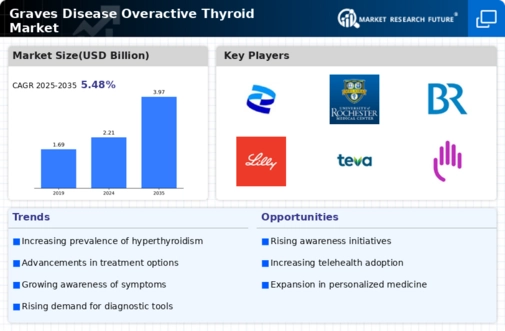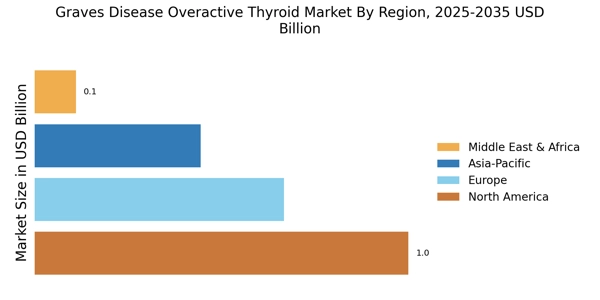Rising Prevalence of Graves Disease
The increasing incidence of Graves Disease is a primary driver for the Graves Disease Overactive Thyroid Market. Recent data indicates that the prevalence of hyperthyroidism, particularly Graves Disease, is on the rise, affecting millions worldwide. This trend is likely attributed to various factors, including genetic predisposition and environmental influences. As more individuals are diagnosed, the demand for effective treatment options escalates. The market is projected to expand as healthcare providers seek innovative therapies to manage this condition. Furthermore, the growing number of patients necessitates enhanced healthcare infrastructure and resources, thereby stimulating market growth. The rising prevalence not only highlights the need for better diagnostic tools but also emphasizes the importance of patient education and awareness, which are crucial for early detection and treatment.
Advancements in Diagnostic Techniques
Innovations in diagnostic methodologies are significantly influencing the Graves Disease Overactive Thyroid Market. Enhanced imaging techniques and laboratory tests have improved the accuracy of Graves Disease diagnosis, allowing for earlier intervention. Technologies such as high-resolution ultrasound and advanced blood tests are becoming more prevalent, facilitating timely identification of hyperthyroidism. This advancement is crucial, as early diagnosis can lead to better management of the disease and improved patient outcomes. The market is likely to benefit from these technological advancements, as healthcare providers increasingly adopt these tools to enhance patient care. Moreover, the integration of artificial intelligence in diagnostic processes may further streamline the identification of Graves Disease, potentially leading to a surge in market demand for related therapeutic options.
Regulatory Support for New Treatments
Regulatory bodies are increasingly supportive of the development and approval of new treatments for Graves Disease, which is a significant driver for the Graves Disease Overactive Thyroid Market. Streamlined approval processes and incentives for orphan drugs are encouraging pharmaceutical companies to invest in therapies targeting this condition. Recent regulatory changes have facilitated faster access to innovative treatments, which is likely to enhance patient care and expand market opportunities. As new therapies receive approval, the market may witness a shift towards more effective and personalized treatment options. This regulatory environment not only fosters innovation but also instills confidence in stakeholders, including investors and healthcare providers, thereby contributing to the overall growth of the market.
Growing Patient Advocacy and Support Groups
The emergence of patient advocacy organizations is playing a pivotal role in the Graves Disease Overactive Thyroid Market. These groups are instrumental in raising awareness about Graves Disease, promoting education, and providing support to affected individuals. As these organizations gain traction, they are likely to influence public perception and encourage more people to seek diagnosis and treatment. Increased awareness can lead to higher rates of diagnosis, thereby expanding the patient population in need of therapeutic interventions. Furthermore, these advocacy groups often collaborate with healthcare professionals to disseminate information about the latest treatment options and research findings. This synergy between patients and healthcare providers may enhance treatment adherence and improve overall patient outcomes, ultimately driving market growth.
Increased Investment in Research and Development
The Graves Disease Overactive Thyroid Market is experiencing a surge in investment directed towards research and development. Pharmaceutical companies and research institutions are focusing on discovering novel therapies and treatment modalities for Graves Disease. This influx of funding is likely to accelerate the development of innovative drugs and treatment strategies, addressing unmet medical needs. Recent reports suggest that the global market for thyroid medications is expected to witness substantial growth, driven by the introduction of new therapies. As R&D efforts intensify, the market may see a diversification of treatment options, catering to a broader range of patient needs. This trend not only enhances the competitive landscape but also fosters collaboration between academia and industry, potentially leading to breakthroughs in the management of Graves Disease.


















Leave a Comment